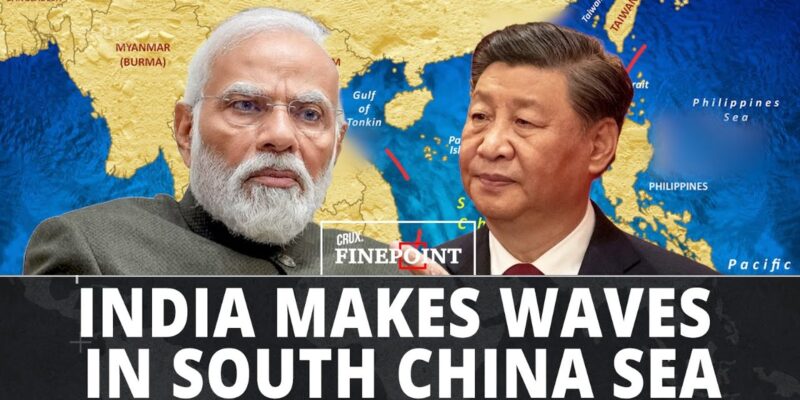
China’s Aggression in the South China Sea and India’s Response
China’s aggressive actions in the South China Sea have raised concerns, leading to India’s firm support for the Philippines against Chinese expansionism.
Background of Chinese Aggression
As I delve into the complexities of Chinese aggression, it becomes evident that the situation is not just a geopolitical tussle but a severe threat to regional stability. Let’s break down the key talking points that highlight the aggressive actions taken by China:
- China bullying the Philippines in the South China Sea: The South China Sea has become a hotbed of tension due to China’s relentless bullying tactics towards its neighboring countries. The recent incident involving Chinese Coast Guard ships menacing a Philippine vessel is a stark reminder of China’s aggressive behavior.
- Chinese Coast Guard threatening Filipino vessels: The alarming confrontation between the Chinese and Filipino vessels is a clear indication of China’s blatant disregard for maritime norms and the safety of other nations’ maritime assets. Such aggressive maneuvers escalate tensions in the region.
- China’s expansionist claims in the region: China’s audacious expansionist claims in the South China Sea have raised eyebrows globally. By asserting dominance over vast maritime territories through its excessive nine-dash line claim, China is challenging the established international laws and maritime boundaries.
These aggressive actions by China not only pose a threat to the sovereignty of neighboring nations but also disrupt the delicate balance of power in the region. It is imperative for the international community to address China’s aggressive behavior and uphold the rule of law in the maritime domain.
India’s Stand Against Chinese Aggression
As I delve into the recent events unfolding on the international stage, it’s clear that India is taking a firm stand against Chinese aggression. From the border standoff in the Himalayas to extending support to the Philippines in the face of China’s bullying tactics, India’s stance is resolute. Let’s explore these critical developments that highlight India’s unwavering commitment to upholding peace and sovereignty.
Border Standoff with China in the Himalayas
The ongoing border standoff between India and China in the Himalayas has been a point of contention for the past four years. China’s audacious claims over Indian territories like Arunachal Pradesh have been met with strong opposition from India. The skirmish in the Galwan Valley in eastern Ladakh in 2020 marked a significant moment where India stood its ground against Chinese incursions.
China’s expansionist ambitions are evident in its relentless pursuit of claiming territories that do not rightfully belong to it. India’s firm resolve to defend its borders sends a clear message that it will not back down in the face of Chinese aggression.
Supporting the Philippines
India’s solidarity with the Philippines against China’s aggressive actions in the South China Sea underscores its commitment to international law and order. During a meeting with Filipino President Maros Jr., Indian External Affairs Minister J. Shanker reaffirmed India’s unwavering support for the Philippines’ national sovereignty.
“India firmly supports the Philippines for upholding its national sovereignty and calls on China to adhere to a rules-based order.”
India’s stance aligns with the principles of the United Nations Convention on the Law of the Sea (UNCLOS), which China frequently violates in the South China Sea. By standing by the Philippines, India sends a strong message to China that unilateral and aggressive actions will not be tolerated.
Indian Navy Chief’s Assertion
At the Indo-Pacific Regional Dialogue in New Delhi, the Indian Navy Chief highlighted the growing instances of Chinese bullying in the South China Sea. He emphasized the need to maintain good order and discipline at sea, condemning China’s aggressive maneuvers that jeopardize maritime security.
“The fragile security situation in the South China Sea poses a clear and present danger, with Chinese militia vessels bullying smaller navies and fishermen.”
By drawing attention to China’s disruptive behavior in the region, India’s Navy Chief echoes India’s commitment to safeguarding international waters and ensuring peaceful coexistence among nations.
India’s proactive measures to counter Chinese aggression in both the Himalayas and the South China Sea demonstrate its resolve to uphold sovereignty, international law, and regional stability. In the face of mounting challenges, India emerges as a steadfast guardian of peace and security in the Indo-Pacific region.
Legal Framework and Disputes in the South China Sea
China’s aggressive actions in the South China Sea have caught the attention of the international community, causing concerns among neighboring countries. The turmoil in this region stems from China’s expansionist tactics and territorial claims that contradict established international laws such as the UN Convention on the Law of the Sea (UNCLOS).
As an individual interested in global affairs, it is fascinating to explore the legal framework governing maritime disputes, particularly in the context of the South China Sea. UNCLOS serves as a cornerstone in determining maritime boundaries and defining the rights and responsibilities of nations concerning their territorial waters, exclusive economic zones, and more.
- UNCLOS: The UN Convention on the Law of the Sea provides a comprehensive set of rules and guidelines for maritime activities, ensuring that countries abide by a rules-based order in their interactions at sea.
- Territorial Waters: These waters extend up to 12 nautical miles from a country’s coastline, granting exclusive sovereignty over this area and the airspace above it.
- Contiguous Zone: Beyond the territorial waters, extending up to 24 nautical miles, where a country can enforce specific laws related to customs, immigration, and environmental protection.
- Exclusive Economic Zone: Extending up to 200 nautical miles, countries have exclusive rights to exploit and manage natural resources within this zone without prohibiting freedom of navigation.
The disputes between China and neighboring countries such as Vietnam, the Philippines, Malaysia, Indonesia, and Taiwan have escalated due to China’s expansive claims over the South China Sea. These disputes are aggravated by China’s construction of artificial islands and militarization of the region, challenging the sovereignty of other claimant states.
China’s unilateral actions in the South China Sea have significant implications, not only for regional stability but also for global trade and security. The South China Sea is a vital maritime artery through which a substantial portion of the world’s trade flows, making it a strategic asset for any country controlling its waters.
Recognizing the importance of upholding international law and the rights of smaller nations, it is crucial for countries like India to stand against China’s aggression in the region. India’s support for nations like the Philippines against China’s coercive tactics demonstrates a commitment to a rules-based order and regional stability.
By adhering to UNCLOS and engaging in multilateral efforts to address disputes in the South China Sea, countries can ensure that maritime conflicts are resolved peacefully and in accordance with established legal principles.
As we witness the ongoing tensions and diplomatic maneuvering in the South China Sea, it is evident that adherence to international law and respect for sovereign rights are essential for maintaining peace and security in this strategically significant region.
Significance of the South China Sea
As I delve into the significance of the South China Sea, I am captivated by the complexities and strategic importance of this maritime region.
- Rich in oil and natural gas reserves: The South China Sea is not just a vast expanse of water; it is a treasure trove of oil and natural gas reserves. Reportedly, it holds an estimated 190 trillion cubic feet of natural gas and 11 billion barrels of oil in proved and probable reserves alone.
- Critical for global maritime trade: Beyond its resource-rich nature, the South China Sea serves as a vital artery for global maritime trade. More than 60% of global maritime trade passes through this region, accounting for one-third of all global shipping. This includes over 30% of the global maritime crude oil trade, highlighting its undeniable importance in the global economic landscape.
- Control over the sea means control over trade: The control over the South China Sea translates to control over global trade routes. Whoever holds sway over this sea holds a significant leverage point in dictating the flow of international trade. This reality underscores the intense competition and strategic maneuvering by nations vying for dominance in this crucial maritime domain.
Understanding the significance of the South China Sea goes beyond mere geographical boundaries; it embodies economic power, strategic influence, and geopolitical implications that resonate on a global scale.
India’s Growing Presence in the South China Sea
My recent dive into the South China Sea has revealed some intriguing developments showcasing India’s expanding footprint in the region. Let’s delve into the key highlights that caught my attention.
Indian Navy ships docking in Manila, defense trade agreements with the Philippines, and India’s strategic interests in the region.
Steering through the waves, Indian Navy ships have made a notable pit stop in Manila, marking a symbolic gesture of solidarity with the Philippines. The camaraderie between our nations extends beyond mere symbolism.
Our defense trade agreements with the Philippines are reinforcing a formidable bond aimed at ensuring mutual security and strategic cooperation in the South China Sea. The dispatch of the potent BrahMos supersonic cruise missiles and discussions on the sale of Tejas light combat aircraft stand as testament to our commitment to bolster the defense capabilities of our Filipino allies.
As I reflect on India’s strategic interests in the region, the significance becomes crystal clear. With over 55% of our maritime trade coursing through these waters, the South China Sea holds immense value for India’s economic vitality. Furthermore, our proximity to the strategically pivotal Indian islands of Andaman and Nicobar accentuates the strategic importance of the South China Sea in our geopolitical calculus.
This escalating engagement by India in the South China Sea is not merely happenstance but a well-thought-out strategic maneuver. By actively participating in the region, India is not only safeguarding its own interests but also contributing to the maintenance of a rules-based order in the maritime domain.
Thus, my journey through India’s growing presence in the South China Sea unveils a narrative of partnership, resilience, and the unwavering pursuit of peace and stability in a region fraught with tensions and power dynamics.
TL;DR
India’s naval ships dock in Manila, defense trade agreements with the Philippines, and strategic interests in the South China Sea underscore India’s proactive stance in fostering regional security and stability.


















